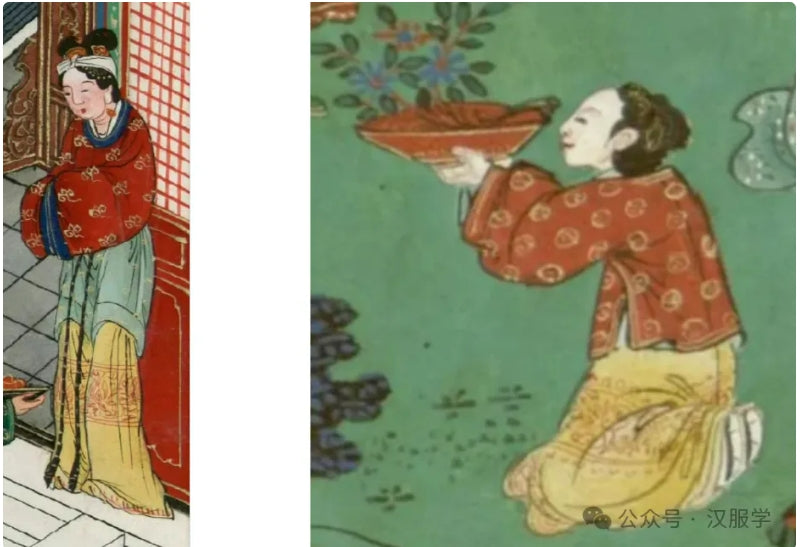2, women in the late Ming Dynasty, of course, wear a skirt covering the skirt of the jacket skirt, a variety of collar in the form of long clothes, but also wear skirts covering the apron, skirt;
3,in the late Ming Dynasty, women's "skirt cover" is to cut long clothes and tie up the waist apron, which is slightly different from the Tang and Song Dynasty skirts and shirts.
In the late Ming Dynasty, women wore colorful dresses. From the perspective of wearing clothes, in addition to the effect of covering skirts and long gowns, there were also waist-length skirts covering clothes.
Skirt covering, that is, the skirt is tied in the outermost layer (refer to the contemporary women's daily wearing of the jacket into the skirt), women in the late Ming Dynasty often tied a skirt around the outermost part of the clothing at the waist.
Women in the late Ming Dynasty did have a large number of ways to wear skirts, but their clothing collocation is slightly different from the "skirts" and "shirtskirts" in the skirt mask program of the Han, Jin, Tang and Song dynasties, the latter are mostly short, while the former is used to a skirt on the basis of a long robe shirt and then a waist. That is, no matter what collar type of gown, in addition to normal wearing, the wearer can add a skirt to wear according to their own needs, so that it shows the effect of skirt covering.
Take the round neck long jacket as an example, the wearing of the red woman in the middle of this water and land painting reflects the real wearing of Wanli years:

This shows that this is recognized as the Ming Dynasty Wanli period women real wear style. And in Jiyuan unearthed a mural in the Ming tomb shows the makeup of the tomb owner's family during the Wanli years, it can be seen that the upper body of the maid's clothing layers from inside to outside are vertical collar clothes, cross-collar clothes and round collar coat, while wearing silk.

It can be seen that in the Wanli years, this style of round neck long jacket is a real daily style.
Let's look at the prints of the Wanli period in the Ming Dynasty, we can see the image of wearing a round neck gown and tying a skirt around the waist, such as the servant in the red circle below:

Compared with the clothes of other women in the picture, the style of the maid's dress is basically the same as that of the maid's coat in the mural of the Jiyuan Ming tomb, the only difference is that the maid in the red circle has a skirt around her waist, and a knot is hanging down the front of the skirt.

Through these two pictures, we can see more clearly that the dress of the servant is more simple and simple than that of the master, but the master and servant are wearing the outer collar collar style, and the inside is a cross-collar dress, the only difference is that the servant is also tied in a waist-length skirt outside the coat, and the knot tie down.
The addition of only one skirt for the attendant should not be an artistic exaggeration of the print, but a reflection of the practicality of the dress of the time.
In the picture, the woman wearing a round neck gown in the red circle tied a belt around the waist, which can fix the bottom of the long clothes from a practical point of view, more convenient activities.
It can be seen that in addition to fixing the hem of the dress to facilitate labor, the waist tie skirt also plays a practical role in protecting the body.
The women's dress, with a skirt only around the circumference, was originally intended to protect the clothing, and later evolved into decorative beyond practical. Even in modern society, men and women in some work, such as cleaning housework, under the kitchen, etc., for the purpose of protecting clothing, will have the habit of wearing aprons, and aprons in addition to only around the waist style, there are also neck styles, their appearance must first meet the practical, A variety of modern aprons are designed to meet users' aesthetic needs to a certain extent.

In this picture, the woman playing on the swing has a skirt around the round neck coat, which is speculated to be used in addition to decoration, but also to protect the clothing.
After the observation of the above materials, is the wearing program of women's skirts covering clothes in the late Ming Dynasty an exception? Obviously not, the actual situation is that many women in the late Ming Dynasty like to tie a skirt in addition to various kinds of long gowns.

When required by work or activities, such as labor, a skirt is tied around the outermost waist, which may be a simple apron, a horse skirt, or a decorative skirt.
Through the above analysis, we can learn that women in the late Ming Dynasty, of course, wore skirts and skirts in the form of various collar skirts, but they also wore skirts and aprons. This is not a painter's imagination, but has practical significance.
1, fixed clothing, does not affect labor. This is just like today when we do some work, we have to wear an apron and tie a waist to play the role of fixed clothing;
2. Protect your clothes from getting dirty. Cover the outside with a skirt, similar to today's apron, is to protect the clothing, avoid getting dirty. For example, today, if we want to clean, we will change into dirty clothes;
3, decorative role. The girth itself is decorative and adds a sense of hierarchy. With a knotted skirt, it has a quaint charm.
Even in modern society, there are situations such as folding clothes to meet actual needs or the pursuit of fashion, such as the emergence of many fake two-piece clothing items is the predecessor of the real two-piece, short-sleeve and long-sleeve folding, vest and shirt folding, two skirts folding, skirt and pants folding, hoodie and skirt folding, etc. In addition to meeting the actual needs of continuous refinement, human beings have never stopped exploring the aesthetic pursuit of clothing in the use process, and how can the simple "skirt mask", which is both practical and decorative wearing program, suddenly completely disappear in real life?
The difference between the late Ming Dynasty and the Tang and Song dynasties is that our general understanding of the "waist skirt" and "waist skirt" is that their top and bottom skirt are the indispensable key components, that is to say, without one of the single products, then the matching style can not be completed. However, the matching shape of the late Ming Dynasty is a complete shape itself, and then add a single product on this basis. This increase is functional and temporary, and does not affect the overall integrity of the wear. Therefore, it is wrong for us to understand the women in the late Ming Dynasty with the logic of wearing jackets and skirts in the Tang and Song dynasties. But we have to admit that we need to re-understand the late Ming women's wearing program - the skirt covered the waist skirt.

